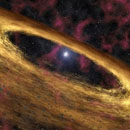Astronomers mystified by 'weird' star
AFP
May 15, 2008
Astronomers are puzzled by the discovery of a pulsar with an unusual orbit never before seen in similar fast-spinning neutron stars that beam regular pulses of radio waves.
Pulsars usually have a circular orbit around white dwarf stars, but the newly found object travels in an oval, or "eccentric," motion around a sun-like star, according to a study posted Friday in the online journal Science Express.
"Pulsars like this are why you do these surveys," David Champion, one of the study's co-authors and an astronomer working at the Australia Telescope National Facility, said in a news release.
"You don't want to just find hundreds of objects, you want to find the two or three that are plain weird and we've found one," he said.
The pulsar, dubbed J1903+0327, is located 20,000 light-years away from Earth and has a mass of about 1.74 times that of the sun, making it heavier than usual.
It also has a speedy rotational period of 2.15 milliseconds, or 465 revolutions per second -- making it the fifth fastest-spinning pulsar known in our galaxy.
"J1903+0327 is totally different in that it has a very eccentric orbit which is elliptical rather than circular," Champion said. "So, the question is: How could it have formed?"
The international team of astronomers believes the pulsar may have been born in a dense region of stars known as a globular cluster before being thrown out by the star it once orbited.
Another theory is that the pulsar may have two companions instead of one. It would be the first tri-star system as about 100 pulsars are part of a two-star team.
Pulsars are born from a supernova, the explosion of a dying, massive star. But sometimes the phenomenon creates black holes or disappears without a trace.
Pulsars were first discovered in 1967 by British physicist Antony Hewish and one of his students, Jocelyn Bell.





 Share your thoughts in the Forum
Share your thoughts in the Forum